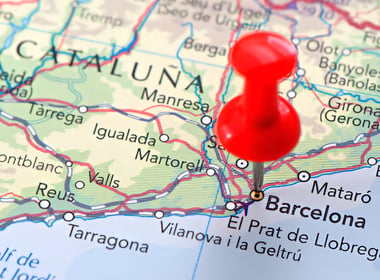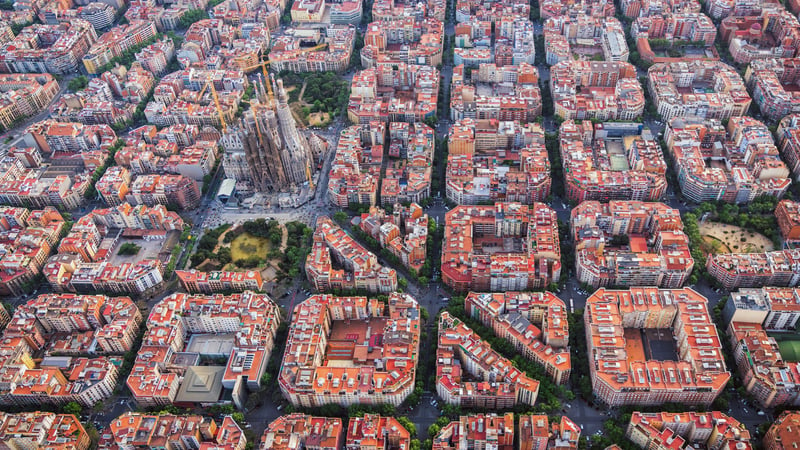İçindekiler
One of the places that impressed me the most when I first arrived in Barcelona was the Eixample. With its wide avenues, eye-catching buildings and unique atmosphere, this neighborhood is like the heart of the city. But the story of Eixample is not just about beautiful buildings. Let’s take a journey through this interesting neighborhood from past to present.
The History of Eixample
The story of the Eixample is, in fact, the story of Barcelona’s growth. In the mid-19th century, the city was trapped inside its walls. The population was growing, but the city could not expand. It was at this point, in 1859, that the plan of engineer Ildefons Cerdà came into play.
Cerdà’s vision was simple but revolutionary: To expand the city and create a modern living space. Eixample means “expansion” in Catalan, and that’s exactly what it would do. Wide, straight streets and characteristic octagonal blocks would breathe life into the city.

It was not just a city plan, but a social revolution. Cerdà aimed to reduce the gap between rich and poor, increase green spaces and create a healthier living space for all.
Why Octagonal Blocks?
The most striking feature of the Eixample is its famous octagonal blocks. But why octagonal? This design was conceived to relieve traffic and create more space in the corners. Thus, a safer and more spacious environment was created for both vehicles and pedestrians.

The Birth of Modernist Architecture: The Golden Age of the Eixample
The planning and construction of the Eixample coincided with the rise of Catalan Modernism. This coincidence profoundly influenced the character of the neighborhood. In the late 19th and early 20th centuries, Barcelona’s economic prosperity and cultural revival manifested itself in architecture. The Eixample became an open-air stage for this creative explosion. Modernist architects rejected traditional forms and developed a style inspired by nature, using innovative materials and combining functionality and aesthetics. The buildings constructed during this period were not just residences or workplaces, but works of art. Colorful ceramics, curving lines, fantastic facades and rich ornamentation have turned the streets of the Eixample into a fairytale land.
Gaudí and Other Masters
Architects such as Antoni Gaudí, Lluís Domènech i Montaner and Josep Puig i Cadafalch turned the Eixample into an open-air museum. Casa Batlló, Casa Milà (La Pedrera) and La Sagrada Família still fascinate visitors today.
These buildings are not just buildings, they are works of art. Each one has its own story. The colorful ceramics and bony balconies on the facade of Casa Batlló, for example, make you want to look again and again every time you pass by.

Eixample Today: Meeting Point of Past and Future
The Eixample is a neighborhood proud of its history, but also looking to the future. Today it is one of Barcelona’s most vibrant and diverse neighborhoods. With its majestic buildings bearing the traces of modernist architecture, it keeps the past alive, while also incorporating all the colors of contemporary life. Especially for shopping and gastronomy, the Eixample is a paradise.
Passeig de Gràcia is one of the main arteries of the neighborhood, with world-famous brand stores and chic restaurants. In addition to luxury brands such as Chanel and Louis Vuitton, there are also boutiques of local designers. But what I really love are the small shops and restaurants serving local delicacies on the side streets, waiting to be discovered.
I once had the most delicious patatas bravas of my life in a small tapas bar I stumbled into on Carrer d’Enric Granados. This experience shows that the Eixample is full of surprises around every corner. From Michelin-starred restaurants to street food, traditional Catalan cuisine to international cuisine.
Eixample is not limited to shopping and dining. With its cultural and artistic events, modern office buildings, green areas and vibrant nightlife, it is truly a living neighborhood. This area, where history and modernism, tradition and innovation are intertwined in every street, is the pulse of Barcelona.
Green Eixample Project
In recent years, the Eixample has been taking steps towards a greener and more sustainable future. The “Superblocks” project is closing some streets to vehicular traffic and opening them to pedestrians and cyclists. It’s like a return to Cerdà’s original vision.

Discover the Eixample: Where to Start?
I have a few suggestions for those who want to explore the Eixample. First of all, make sure you see La Sagrada Família. Don’t just look at it from the outside, go inside. The light plays and details inside are incredible. A walk along Passeig de Gràcia is great for observing both architecture and city life, and be sure to visit Casa Batlló and Casa Milà. Finally, don’t be afraid to get lost in the back streets of the Eixample.
The Eixample is a unique neighborhood that combines the past and the future of Barcelona. Every time I visit, I discover something new and I am sure you will have a similar experience. While visiting this neighborhood, you will see how different a city can be when planned.
I recommend you also check out the Sant Antoni guide, which is planned as a continuation of the Eixample district.








